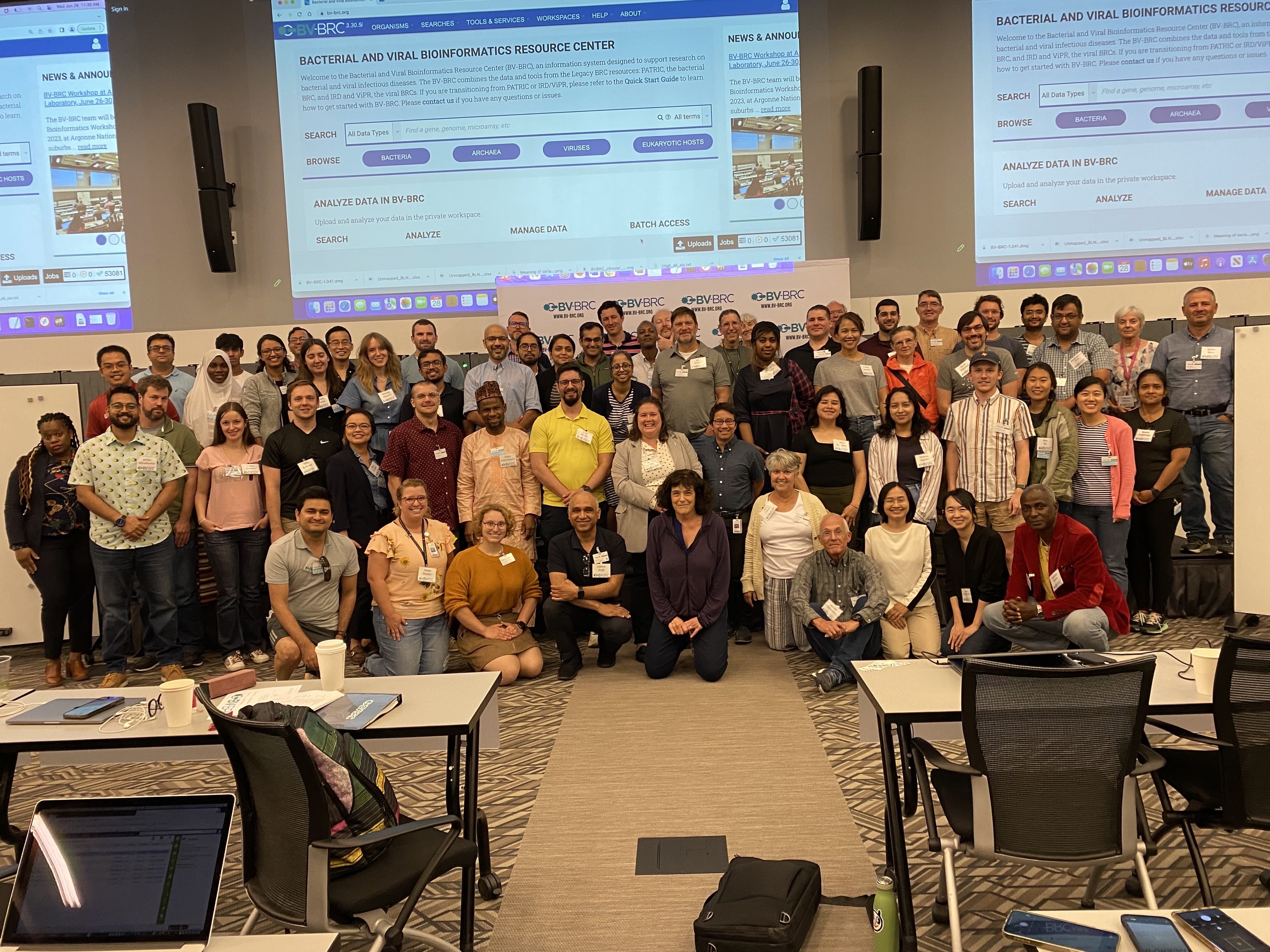BV-BRC Workshop at Argonne National Laboratory, February 24-28, 2025¶

The BV-BRC (Bacterial and Viral Bioinformatics Resource Center) team will be offering a Bioinformatics Workshop on February 24-28, 2025, at Argonne National Laboratory in the suburbs of Chicago, IL. The workshop will show researchers how to analyze and explore bacterial and viral pathogen data using the BV-BRC website, focusing on bacterial, and viral examples and workflows.
This workshop will have two separate components, and researchers can register for one or both. The bacterial component, concentrating on analyzing antimicrobial resistance data, will take place on Monday, February 24th to mid-day on Wednesday, February 26th. The viral component will begin Wednesday, February 26th and concludes on Friday, February 28th.
Researchers can sign up for one or both of these sessions and must state their preference(s) when they register (see Registration below).
The workshop will consist of interactive hands-on training sessions. During Days 1-2 (February 24-25) the workshop will concentrate on exploring and analyzing bacterial antimicrobial resistance data. Participants will learn how to search for public datasets of interest and perform genomic, comparative genomic, metagenomic, and transcriptomic analyses using various analysis services and tools at BV-BRC.
The morning session of Day 3 (February 26) will focus on using the BV-BRC command-line interface for programmatic search and retrieval of data and submission of analysis jobs. Users will also have the opportunity to work with their own data and analysis problems with assistance from the BV-BRC team members.
The viral component begins on the afternoon of Day 3 (February 26), concentrating on searching for data performing phylogenetic and comparative genomic analyses. Day 4 (February 27) focuses on sequence assembly and annotation, subspecies classification, protein structure, surveillance data exploration, sequence feature variant data and transcriptomic analysis. Day 5 (February 28) includes the docking service, and hands-on exercises.
REGISTRATION
Registration is now closed for this workshop. If you are interested in attending a future BV-BRC workshop- check back in soon to hear about upcoming workshops.
LOCATION
AGENDA
BV-BRC Workshop Schedule¶
Day One - Monday, 24 February (Bacterial)¶
- 9:00 am Bacteria - Information, registration, and overview
Welcome and registration
Overview (www.bv-brc.org)
Creating genome groups
- 10:00 am Taxonomic Classification
Description of Kraken2
Uploading reads and submitting job
Viewing and interpreting the results
- 10:45 am Metagenomic Read Mapping
Description of CARD and VFDB and job submission
Viewing and interpreting results
11:00 am Break
- 11:15 am FASTQ Utilities
Description of FASTQ files and service
Selecting pipeline (Trim, FastQC, Paired read, Align)
Uploading reads and submitting job
Viewing and interpreting results
12:00 pm Lunch
- 1:00 pm Metagenomic Binning
Description of algorithm
Uploading reads or contigs and submitting the job
Viewing and interpreting the results
- 2:00 pm Comprehensive Genome Analysis Service
Description of assembly and annotation algorithms
Uploading reads or contigs and submitting job
Viewing and interpreting results
3:00 pm Break
- 3:30 pm Similar Genome Finder Service
Description of MASH/MinHash
Submitting job
Viewing and interpreting results
- 3:45 pm Phylogenetic Tree Building Service
Creating a genome group
Determining if selected genomes are “treeable”
Description of algorithm and submitting tree-building job
Viewing and interpreting results
Newick file download
4:45 pm Question and Answer Session and Hands-on Work
5:00 pm Day 1 Adjourn
Day Two - Tuesday, 25 February (Bacterial)¶
9:00 am Review of Day 1
- 9:15 am BLAST
Choosing BLAST database, parameters, and job submission
Viewing and interpreting the results
- 10:00 am Comparative Services (Protein Families, Pathways, and Subsystems)
Description of protein families and job submission
Finding the pan, core, and accessory genomes
Visualizing and manipulating the heatmap viewer
Finding specific differences, downloading, and saving results into private workspace
Comparing pathways on pathway map and heatmap
Finding specific differences, downloading, and saving results into private workspace
Description of Subsystems
Exploring subsystems using the tabular and heatmap views
Finding specific differences, downloading, and saving results
11:00 am Break
- 11:15 am Proteome Comparison
Selecting genomes for study and job submission
Visualization of compared genomes and analysis results
12:00 pm Lunch
- 1:00 pm Compare Region Viewer
Feature overview
Description of calculations for gene neighborhoods
Adjusting the view
Viewing data of interest (genome and feature groups)
- 2:00 pm SNP and MSA Variation Service
Description of algorithm, selection of genes and job submission
Viewing and interpreting the results
- 2:45 pm Gene Tree
Description of algorithm, selection of data and job submission
Viewing and interpreting the results
3:15 pm Break
- 3:30 pm Variation Service
Description of aligners and SNP callers
Discussion and selection of target genomes
Downloading and using data
Interpreting results
4:30 pm Install Command Line Interface
4:45 pm Question and Answer Session and Hands-on Work
5:00 pm Adjourn